I have a working solution to this question.
1. Prerequisites
My two APIs / endpoints are as follows.
{
"US-employees": [
{
"id": "Q37079",
"name": "Tom Cruise"
},
{
"id": "Q844",
"name": "James Bond"
},
{
"id": "Q11666",
"name": "Maria Sharapova"
}
]
}
{
"US-portraits": [
{
"id": "Q844",
"description": "Fictional British spy",
"image": "https://upload.wikimedia.org/ [...] _Bangalore_144323.jpg"
},
{
"id": "Q11666",
"description": "Russian tennis player",
"image": "https://upload.wikimedia.org/ [...] _%2843186339350%29.jpg"
},
{
"id": "Q37079",
"description": "American actor and producer",
"image": "https://upload.wikimedia.org/ [...] _Skidmore_2.jpg"
}
]
}
where I have truncated the links of the images for better readability.
(Just click the
/emps/empid
link to see the unabbreviated version.)
Notice in the first endpoint how each object / person has a unique
id and a name, nothing more.
The second API has – for each object in the first endpoint – the same
unique identifier, along with a description and a link to an image /
portrait.
Thus, neither of the two APIs on its own contains information on both the
name and the image link.
2. The result
Obviously, the problem is solved if the data in the two APIs can be combined
together in such a way that – for each identifier – both the name and the
image link are supplied. Like so:
[
{
"id": "Q37079",
"name": "Tom Cruise",
"description": "American actor and producer",
"image": "https://upload.wikimedia.org/ [...] _Skidmore_2.jpg"
},
{
"id": "Q844",
"name": "James Bond",
"description": "Fictional British spy",
"image": "https://upload.wikimedia.org/ [...] _Bangalore_144323.jpg"
},
{
"id": "Q11666",
"name": "Maria Sharapova",
"description": "Russian tennis player",
"image": "https://upload.wikimedia.org/ [...] _%2843186339350%29.jpg"
}
]
All that remains is to visualize the data in Postman:

3. Methodology
I make the request to the
/emps/usa API as a
normal GET request in Postman:
GET http://henke.atwebpages.com/postman/chaining/emps/usa
I probably could have made the request to the
/emps/empid API
as an ordinary Postman request too – and then combined the two
requests via Postman's Collection Runner.
But instead I make the request to the
/emps/empid API
in a Pre-request script, as follows:
const url = 'http://henke.atwebpages.com/postman/chaining/emps/empid';
pm.sendRequest(url, (err, response) => {
pm.environment.set('US_portraits',
JSON.stringify(response.json()['US-portraits']));
});
Then, in the Tests section, I combine the two results together, and
finally visualize them:
const usEmployees = pm.response.json()['US-employees'];
const usPortraits = JSON.parse(pm.environment.get('US_portraits'));
usEmployees.map(x => Object.assign(x, usPortraits.find(y => y.id === x.id)));
const tblHeader = Object.keys(pm.response.json())[0];
const template = `
<table>
<tr><th>` + tblHeader + `</th></tr>
{{#each response}}
<tr><td>{{name}}<br><img src="{{image}}"></td></tr>
{{/each}}
</table>`;
pm.visualizer.set(template, {
response: usEmployees
});
4. How to replicate my solution in Postman
Replicating my results in Postman should be straightforward.
Assuming you are using the desktop version of Postman, do as follows:
Download and save
http://henke.atwebpages.com/postman/chaining/emps/API-Chaining.pm_coll.json
in a suitable place on your hard drive.
In Postman, Ctrl + O > Upload Files >
API-Chaining.pm_coll.json > Import.
You should now see API Chaining among your collections in Postman.
Collections > API Chaining > US-empl-request > Send.
In the Postman Response Body, click Visualize.
Done! – If everything worked as intended, you should now see the output as
in the image above, starting with the name and image of Tom Cruise.
5. Two questions by the original poster + one extra
Question
how can I read and hold data for each employee id and then call the 2nd API
in the collection as many times I have received an employee id?
Answer
I call the two APIs just once each, and then do whatever needed with the data
retrieved.
I get two JavaScript arrays, one from each of the two APIs.
The essence of the problem boils down to joining two JavaScript arrays that
have a common unique identifier.
Question
Is there any way to call an API from Postman's Tests section?
Answer
Yes! – In the above solution, I make the necessary API requests before the
Tests section kicks in.
Then I devote the Tests section to getting the data from the requests –
saved in two environment variables – and finally manipulate that data to
reach the end goal.
But you can do it all in Tests. See the last section below.
Question
But hey, this isn't chaining any more! –
There is no second request using information from the first request.
Right?
Answer
That's right! – It doesn't matter which request is put in the Pre-request
script, and which is run as the ordinary request. Swapping them should work
just as fine. The point is: the asker of the question thought of the problem
as a need to make chaining requests.
(And I present one such solution in the next section.)
It turns out that chaining requests are not necessary to solve the
problem.
6. Doing it all in the Tests section
You can actually do literally everything in the Tests script.
Although chaining requests are not strictly necessary to solve the problem,
here is a solution with code only in the Tests section, which does
apply a second chaining request.
The second request does not depend on any data from the first request, but the
second callback needs data from both requests.
(The main request is just a dummy request never used – except for start
running the Tests script.)
Both requests are made in the script, then combined, and finally visualized:
1
const lock = setTimeout(() => {}, 43210);
const urlO = 'http://henke.atwebpages.com/postman/chaining/emps/empid';
const urlI = 'http://henke.atwebpages.com/postman/chaining/emps/usa';
pm.sendRequest(urlO, (_, responseO) => {
const usPortraits = responseO.json()['US-portraits'];
pm.sendRequest(urlI, (_, responseI) => {
clearTimeout(lock); // Unlock the timeout.
const usEmployees = responseI.json()['US-employees'];
usEmployees.map(x => Object.assign(x,
usPortraits.find(y => y.id === x.id)));
const tblHeader = Object.keys(responseI.json())[0];
const template = `<table>
<tr><th>` + tblHeader + `</th></tr>
{{#each responseI}}
<tr><td>{{name}}<br><img src="{{image}}"></td></tr>
{{/each}}
</table>`;
pm.visualizer.set(template, { responseI: usEmployees });
});
});
Postman Collection to replicate this Tests-only version:
http://henke.atwebpages.com/postman/chaining/emps/API-Chain.sendReq.pm_coll.json.
References
1 Don't get confused by the lines
const lock = setTimeout(() => {}, 43210); and clearTimeout(lock);. –
Their only purpose is to serve as a workaround for a known bug.
